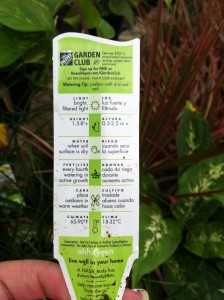As a follow up to a previous blog entry, where we discussed how important it is to know your home’s orientation to better understand where the sun and shade is in your yard, it is also important to discuss a plant’s light requirements. You’ve probably gone to your local home improvement store to buy plants for your yard and encountered that little paper that tells you what the plant’s light and water requirements are. In case you have ever been confused, here is a quick breakdown of each light category:

Most home improvement stores identify their plants with labels, like the one above. Be sure to consult these labels for your plant's light, soil, and water requirements before you plant it!
Full Sun– This means that a plant needs sun for the majority of the day, at least 6 hours.
Part Sun/Part Shade– These two categories are often thought of as interchangeable but that’s not exactly the case.
Part Sun plants require direct sunlight for at least a portion of the day and they will tolerate shade for the rest of the day. They may not survive and will certainly not be as full and healthy if they do not receive some sunlight during the day.
Part Shade plants require shade, especially in the hot summer months, for a least a portion of the day. They can tolerate some direct sunlight but can have sun damage during the summer with no protection from the sun. Some plants in this category like dappled light, which is light that passes through deciduous trees. Many part shade plants thrive in this indirect light.
Full Shade– These plants cannot take prolonged periods of direct sunlight. They require shade for the majority of the day, especially in the afternoon. This is especially important in Central Florida, where the summer sun is brutal and most full shade plants will tolerate very little, if any, direct sunlight.
An important extra tip to remember: The hottest part of the day is between 1:00-4:00 pm, making afternoon sun much hotter and more intense than morning sun. If you have a part-sun plant, you may consider planting it where it will have afternoon sun and morning shade. Inversely, part-shade plants will do best when given morning sun and afternoon shade. Remember that your home’s orientation determines its sunny and shady areas. The eastern side of your home receives morning sun and the western side gets the hotter, afternoon sun. Also, remember that each plant is a little different and may not fit exclusively into one of these categories. There are also a lot of other considerations, like water requirements and soil pH to take into account when planting a plant. Stay tuned for our next blog to hear more about these considerations!
If you have any questions or you would like to schedule a free estimate, email us or call us at 407-935-9151.

0 Comments